This was published 6 years ago
Trekking in Nepal: Why you should visit this stunning country now
By Louise Southerden
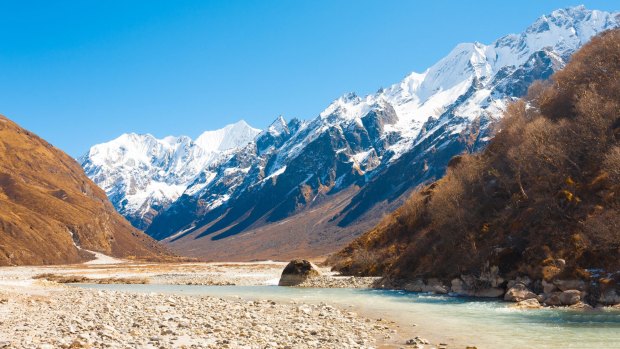
Langtang Valley.Credit: Alamy
"Namaste!" It's so faintly chirped I almost don't hear it, until I stop walking and look around. Then I see her, a child no older than five standing in a nearby potato field in tattered clothes, her hands pressed together in front of her chest. She smiles. I smile back. "Namaste," I say, and walk on. Big mountains might lure us to Nepal, but it's small moments like these, encounters with the people who live in the landscapes we've come to see, that keep us coming back.
This is my third visit to Nepal, my first since 2015 when the country was rocked by a magnitude 7.8 earthquake and its aftershocks. More than 9000 people died and hundreds of thousands were left homeless. An estimated eight million people were affected, according to the UN. When I first arrive in Kathmandu the city seems much as I remember it, but with more dust, from roadworks and reconstruction. Scratching the surface, however, it's clear that three years isn't long in a place like this. Some of Kathmandu's World Heritage-listed landmarks remain caged in scaffolding, off-limits to visitors. And the earthquake is still very much in people's minds.
Everyone has a story about where they were at 11.56am on April 25, 2015, and what, and who, they lost. It's in my mind too, because I'm here to do a new trek run by Intrepid Travel in one of the regions hardest hit by the earthquake, the Langtang Valley just north of Kathmandu.
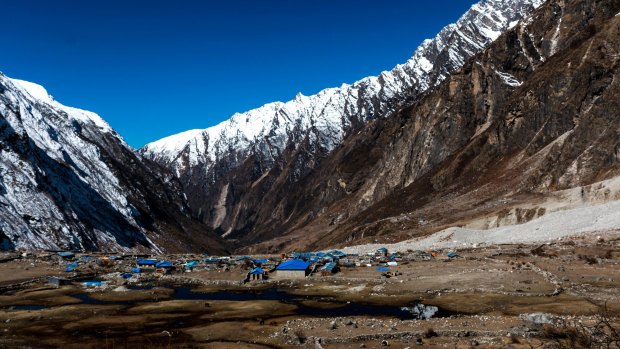
After the earthquake in 2015 Langtang, Langtang Valley.Credit: Alamy
As the largest trekking operator in Nepal, Intrepid has played a key role in helping the country's trekking industry get back on its feet. They worked with an international team of earthquake engineers on the first-ever safety assessments of major trekking routes in the Everest region, the Annapurnas and the Langtang Valley after the quake to reassure visitors it was safe to return. They donated all their profits from the 2015-16 trekking season and ran a year-long fundraising campaign to support five local and international NGOs rebuilding the country.
"We thought we might raise $10,000 then we raised $40,000 in the first 24 hours and we ended up raising $750,000, which is a testament to what a special place Nepal is and how much it touches people as a destination," says James Thornton, Intrepid's Melbourne-based CEO.
Finally, in October 2016, Intrepid started a new trek to bring much-needed income to the Langtang Valley, which had been closed to trekkers until then, and to "share the love" on the nearby but less-visited Tamang Heritage Trail. So this is a tale of two trails: Tamang first, then Langtang.
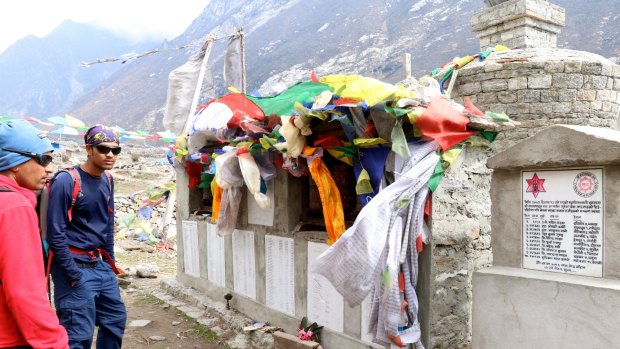
Prayer flags over the memorial mani wall in new Langtang village.Credit: Louise Southerden
TAMANG TREKKING
Our first day on the Tamang Heritage Trail is a taste of things to come. We set off from the town of Syabrubesi, a day's drive from Kathmandu, cross the road in front of our hotel and head immediately, steeply, uphill.
While our three guides, Raj and his two assistants Minh and Ritess, ease us into the trek with the Nepali trekking mantra "slowly, slowly", we pace ourselves by talking as we walk, getting to know each other. My nine fellow trekkers include a police officer from Penrith, an architect from Switzerland, a vegan couple from northern England and a radiographer from South London. Our five porters, carrying our luggage in red duffel bags supplied by Intrepid, are hours ahead of us, having left the hotel while we'd been at breakfast.
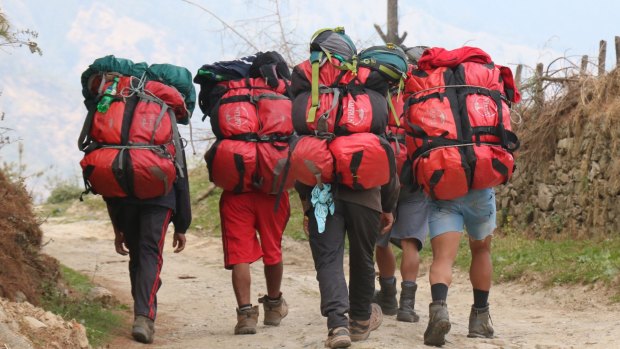
Porters carrying our red duffel bags.Credit: Louise Southerden
Our destination that afternoon is the village of Gatlang, where we stay in a teahouse, basically a family-owned guesthouse, as we do every night. The rooms are monastically basic, with bare wooden walls and floors, but they're comfortable enough, with twin beds (BYO sleeping bag) and shared bathrooms. Although it's a low-altitude hike by Nepal standards – our highest point that first week is an alpine meadow at 3100 metres – it's surprisingly steep. We become intimately acquainted with stone steps and zig-zagging tracks. But the steep terrain has advantages. Every switchback yields a new perspective: a drone-like overview of that village we'd left half an hour ago or a range of snowy peaks peeking over the next forested ridge.
On the morning of day two we see Ganesh Himal, a range straddling the Tibetan border, and Raj, who happens to be a Hindu priest as well as a trekking guide, tells us the story of the elephant-headed Hindu god it's named after. The mountains we see from this trail might not be the rock stars they are in other parts of Nepal, but they're not what we're here for.
The real beauty of this trail is that it gives us a chance to walk with the Tamang people. Descended from Tibetan horse traders who made seasonal migrations from the Tibetan plateau down to the Nepalese lowlands, the Tamangs settled the steep green valleys in between a few hundred years ago. Daily life hasn't changed much since then, if you ignore the solar panels on some roofs and the occasional mobile phone. Most of the villages we visit can be reached only on foot. In five days we see only three other trekkers. Instead, we share the trail with men carrying bundles of firewood on their backs, curved knives tucked into the sashes they wear as belts. We pass women working the fields wearing traditional tunic-like dresses, coral necklaces and felt hats. One morning we step aside to let an elderly couple pass; on their shoulders are heavy wooden farm tools that would look more at home in a museum.
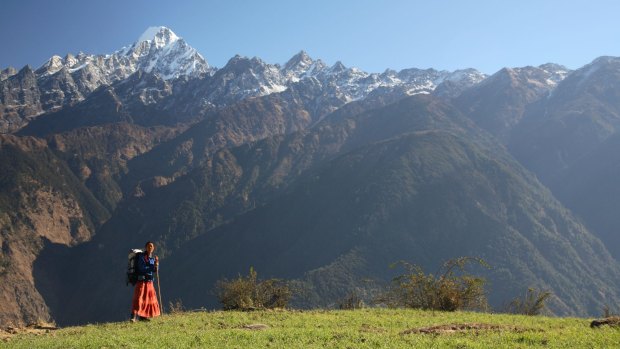
A Trekker on the Tamang Heritage Trail.Credit: Alamy
There are few trips as simplifying as a guided trek. With every passing day, I think less and notice more. Raj tells us when to wake up, when we need to set off, where we'll stop for morning tea. Even at mealtimes, decision-making is kept to a minimum: every teahouse has the same menu, usually porridge or muesli for breakfast; momos (Nepalese dumplings), dal bhat (rice, lentil soup and curry), noodles or pasta for lunch and dinner; and apple pie for dessert, if we're lucky. One day we descend a steep slope and it suddenly smells like Christmas: we've ambled into a pine forest. Other days we weave between mossy-trunked oak trees, listening to the knock-knock of woodpeckers and cuckoos that really do sound like Swiss clocks. Twice we see black-faced langur monkeys. Then there are the rhododendrons, "rhodos" as the South Londoner calls them. They're everywhere: enormous trees dotted all over with pink, snow-white and blood-red posies. That's one good reason to trek in spring; it's Nepal's version of Japan's cherry blossom season.
On the morning of day four, Raj points directly across the valley to where we're headed that day: the village of Briddim. It looks so close. Getting there takes us all day. But trekking in such an open landscape, being able to see where you're going and where you've been, recalibrates your sense of distance and restores an ancient confidence that you can travel far on foot.
On the way to Briddim, we come to a suspension bridge badly damaged by rockfall during the earthquake. One end is now a patchwork of stone slabs and the railings are missing so I'm glad to see the porters there, waiting to join the guides to help us all across, one by one. It's not the only time we see evidence of earthquake damage – and rebuilding slowed by remoteness and having to transport materials on foot and work by hand.
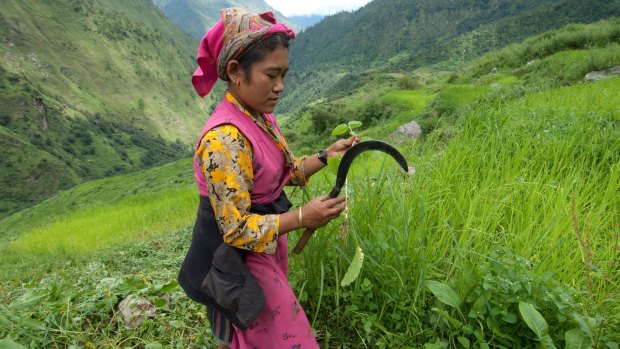
A woman at work in the Trisuli Valley.Credit: Alamy
In one village the afternoon sun glints off shiny corrugated tin roofs that have replaced traditional wooden shingles. In another, new wooden houses outnumber old stone ones. Blue tarps emblazoned with foreign aid logos span still-gaping holes in walls. Everywhere there's the smell of sawdust and a soundtrack of sawing and hammering.
"Happy new year!" says Raj at breakfast on day five. It's April 14 to us, new year's day to him. "It's now 2075 [by the Nepali calendar]," he announces, enhancing the feeling that we've stepped out of our own time into another. It also seems an auspicious date to start the second half of our trek. Before the earthquake, the Langtang Valley was Nepal's third most popular trekking region after the Everest region and the Annapurnas. It's an ideal trek for first-timers, promising big-mountain views for minimal effort: the trailhead is close to Kathmandu, it's not as steep as the Tamang trail and you can walk up the valley and back in less than a week.
LANGTANG VALLEY
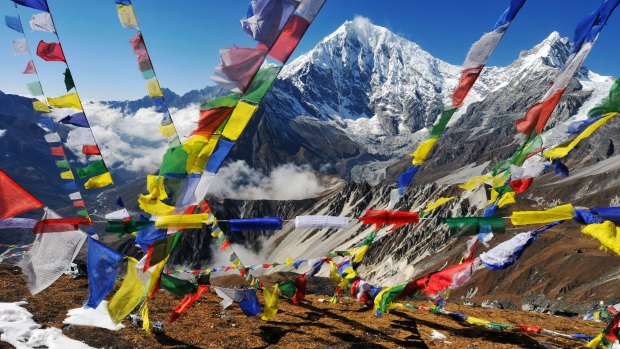
Langtang Valley.Credit: Alamy
There's also something mystical about the Langtang Valley. Its name comes from a Tibetan legend about a lama who stumbled on it while searching for his missing yak. It's said to be inhabited by yeti as well as red pandas and black bears. And when the first Westerners visited in 1949, at a time when Nepal was just reopening to outsiders, their expedition leader, British explorer Bill Tilman, described it as "the most beautiful valley in the world". It's not hard to see why.
That first morning the trail gently climbs through an enchanted forest at the base of a deep ravine; beside us flows the rushing Langtang River. The forest gives way to wild gardens of rhododendrons then we're above the treeline in a classic U-shaped valley carved by glaciers and flanked by snowy 6000 and 7000-metre peaks offering the kind of top-to-bottom mountain views Nepal is famous for.
Here, too, we see regular reminders of the devastation this region suffered, and its ongoing recovery.
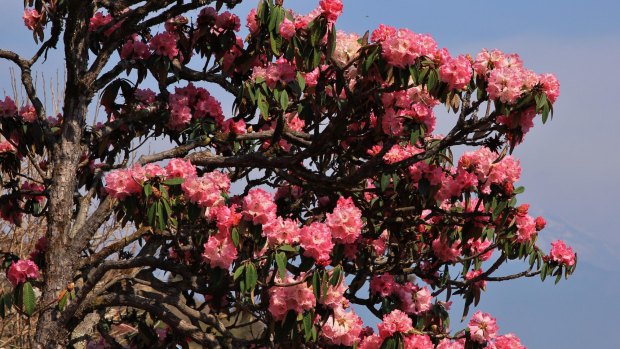
Blooming pink Rhododendron.Credit: Alamy
Whenever we hear the jangling of bells, we step off the track to let donkey trains pass carrying sandbags. We give way to youths bent double under timber planks strapped to their backs. We pass men rebuilding sections of the track damaged by rockfall.
But nothing prepares us for the Langtang landslide. On April 25, 2015, this mass of rock, ice and snow fell without warning from the mountains above, burying the village of Langtang in a matter of minutes. More than 300 people were killed, including 175 locals and 41 foreign trekkers; many bodies were never recovered. The pressure wave flattened every tree on the other side of the valley. A single house survived because of its location snug against the base of the cliff; it's deserted now, a haunting reminder of the village it used to be part of.
The dusty trekking trail that once weaved through the village now goes over the top of it. There's no way around it; the landslide covered the entire valley floor. It's so broad it takes us half an hour to cross it. No one speaks. Not a blade of grass has regrown in three years. Power poles dot the vacant expanse like road markers. At one point we hear trickling water; beneath the rubble, mountain streams still flow, in darkness now.
I'm walking beside Raj when we meet 80-year-old Churi Dendu Sherpa walking the other way. He lost seven members of his family in the landslide, he tells us, taking off his hat and fingering the prayer beads around his neck. He points to where his house used to be.
Just beyond the landslide, a new Langtang village is slowly being rebuilt. We stop at a concrete stupa so new there's still formwork around it. At its base is a memorial mani wall listing the names of all those who perished, beneath an inscription, "Not a day passes when you are not loved and missed".
We stay at a new teahouse called Tibetan Guest House; owner Sangbu Tamang lost his first guesthouse, and many friends, in the landslide, but this will always be home, he says. "I love my village because I was born here. I know the water, I know the stone, I know the lakes, where the streams are, where the rocks are; even if I have to walk during night time, I know this place. And tourists are coming back. Not like before, but slowly coming back."
That afternoon we're invited to join a Buddhist ceremony under way in the new community hall. We sit at the back beside old women in down jackets spinning prayer wheels, listening to lamas and locals chanting Buddhist sutras. Young women pour us cups of masala tea from huge kettles and keep the yak butter lamps at the front of the hall burning. Over dinner at the guesthouse later, Sangbu Tamang explains what's going on. "We are Buddhist and in Tibetan Buddhism we have new year, we call it Losar, when we change the prayer flags. But we have not done that for three years; we don't sing, we don't do anything, because so many people died here. But after this ceremony is finished [on April 25 this year] then we are fresh. Then we can put prayer flags around again."
The next day, we walk into a postcard. Our destination, the village of Kyangjin Gompa, is only three hours up the valley from Langtang and a world away. It's 3850 metres above sea level, but we're going higher still.
We wake at 3.30 the next morning, to climb a mountain. Even in the dark, the track to the 4773-metre summit of Kyangjin Ri is easy to find; it starts behind our guesthouse. From there we become a conga-line of head torches climbing up and up, our boots crunching on fresh snow. As the stars fade, we see the outlines of the mountains around us. Then details appear; it's like watching a photograph develop in a darkroom. By 5.30am we're standing at the centre of a 360-degree view. Even with all 10 of us there and the guides, it's the definition of peaceful. Someone rings a golden bell hanging from a string of prayer flags.
The sun is a no-show; clouds engulf the scenery instead, swirling around us as we start our descent, and by 7.30am we're back in the village ordering lattes and chocolate croissants from one of Kyangjin's cafes. Did we really just climb a mountain before breakfast? While the mountains play hide and seek with the clouds, we read, play cards and eat soup for lunch in the rooftop restaurant of our four-storey teahouse. By late afternoon we've got cabin fever so Raj takes us on a short walk up the valley to see a lake. It's bitterly cold, even wearing all the clothes I'd brought, until our faithful porters (in jeans and sweatshirts) start singing and before we know it we're all dancing and warm and happy.
The next day we retrace our steps back down the valley. It's the longest day of the whole trip: seven hours on the trail. Crossing the landslide again is no less sobering than it had been two days earlier. Then we follow the Langtang River and descend through the forest to a riverside teahouse, where I kick off my boots and soothe my trail-weary feet in the icy water.
As I sit on a sun-warmed rock, the roar of the river envelops me, drowning out all other sounds, giving me time to process all I'd seen and felt these past two weeks. For this trek is unlike any I've done, anywhere, its recent history adding an emotional dimension to everything we'd experienced.
Trekking in Nepal always has the potential to be affecting. Trekking in a region like this, right now, takes it to another level, letting you step into a tale of loss and hope as old as humankind, a story about the power of nature and our ability to survive, told by rebuilt teahouses and trekking trails and villages that haven't changed in centuries and children calling out to passing trekkers, "Namaste".
TRIP NOTES
FLY
China Southern Airlines flies from Sydney, Brisbane and Melbourne to Kathmandu via Guangzhou; see www.csair.com/au/en
Nepal tourist visas are available on arrival for $US25 (15 days) or $US40 (30 days), payable in AUD cash.
TREK
Intrepid Travel's 15-day Tamang Heritage & Langtang Valley Treks run February-May and October-November. The trip costs $1455 a person twin share including transport, trekking permits, accommodation, porters and a local guide but not meals (which will cost an extra $200-300). See intrepidtravel.com
STAY
Kathmandu Guest House, actually a 103-room family-owned hotel, in Thamel, the heart of Kathmandu, is an atmospheric base for extra nights before or after the trek and has rooms from $US45 a night including breakfast and Wi-Fi. See ktmgh.com/kathmandu-guest-house/
MORE
Louise Southerden travelled as a guest of Intrepid Travel.
FIVE MORE ADVENTURES YOU CAN DO IN NEPAL
1. "ZIP FLYING"
Just outside Pokhara, Nepal's second city, is the world's longest, steepest zipline where you can "fly" into mountain views at 120km/h, 600 metres above the ground for 1800 metres. See highgroundnepal.com
2. WHITEWATER RAFTING
Raft Nepal has been running Nepal's rivers since 1992 and has short (1-3 days) and longer (7-11 days) rafting trips on the Trisuli, Kali Gandaki and other Nepalese rivers, even during monsoon season. See raftnepal.com
3. MOUNTAIN BIKING
The Annapurna Circuit, once a world-class hike, is now a world-class mountain bike trail since it became a single-lane road to service local communities living between two of Nepal's highest peaks. See worldexpeditions.com
4. ROCK CLIMBING
Nepal isn't just for mountaineers; there are great rockclimbing crags too. Hardcore Nepal offers day trips for first-timers as well as multi-day climbing, caving and canyoning trips close to Kathmandu. See hardcorenepal.com
5. WILDLIFE SAFARIS
See wild rhinos, elephants, maybe even a Royal Bengal tiger on a jeep, walking or canoe safari in one of Nepal's subtropical national parks such as Chitwan or Bardia. See bardiahomestay.com
FIVE ESSENTIAL TIPS FOR FIRST-TIME TREKKERS
1. The best times to trek in Nepal are either side of the summer monsoon season: April-May (to see rhododendrons in bloom) and October-November (for clear skies that ramp up the mountain views).
2. The trek to Everest base camp is popular, but can get unpleasantly crowded; try instead the trek to Gokyo Ri, also in the Everest region, or the Annapurnas, which has a great range of treks.
3. It's a good idea to do some pre-trek training such as regular aerobic exercise (walking, swimming, cycling), a few day-hikes and some stair-climbing.
4. You'll need hiking boots, a comfortable daypack, a rain jacket and a good sleeping bag. Trekking companies such as Intrepid provide gear lists and if you forget anything there are outdoor shops galore in Kathmandu and Pokhara.
5. You can't drink the tap water in Nepal, so bring a refillable bottle and some water filtration tablets such as Aquatabs (available in Kathmandu) to avoid buying bottled water and adding to Nepal's plastic waste.
See also: No camping: The world's best walks you can do in a day
Sign up for the Traveller Deals newsletter
Get exclusive travel deals delivered straight to your inbox. Sign up now.